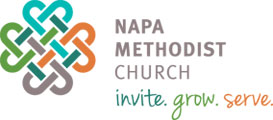Unfortunately the pressure of heavy financial responsibilities overwhelmed the mission church, and in spite of sacrificial stewardship of incomes and energies it became necessary to terminate the project and to merge Church of the Valley with First United Methodist Church in 1972. The merger brought great strength to the unified church — strength in leadership and in tangible assets from the sale of the Church of the Valley’s organ. Hopewell Baptist Church now occupies the site of the Methodist Church of the Valley.
The parsonage which shared the church site for 98 years was replaced in 1965 with a new parsonage purchased in Browns Valley. The old parsonage was sold and moved to Polk Street and the present parking lot created in its place. The old parsonage was finally razed to create more parking for the bank next door to it on the corner of Polk and Franklin streets.
Following the legacy of the founder of Methodism, John Wesley, the Napa Methodists have a long history of supporting the social gospel of justice and inclusion. In the 1970s the church marched with the United Farm Workers. Church and Society Committee members stood in the street outside the Lawrence Livermore facility and protested nuclear weapons work. In the early 1980s the congregation was the organizing force behind the Napa Creek Manor senior housing facility on Jefferson Street. In the late 1990s they began to pursue making Centennial Hall available to house a homeless drop-in facility, and so the HOPE Center was born.
